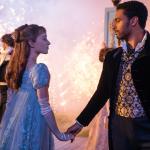In Netflix's 'Bridgerton,' Shonda Rhimes Reinvents How to Present Race in a Period Piece

Television and cinema have had a long love affair with Great Britain during the lush Regency era. From classic novels reimagined on screen, like "Pride and Prejudice" and "Emma," to historical dramas about their authors, like "Becoming Jane" and "Bright Star," there has always been something intriguing for moviegoers about this period. But in Netflix's new series "Bridgerton," premiering on Christmas Day, producer and media mogul Shonda Rhimes, along with "Scandal" and "Grey's Anatomy" producer Chris Van Dusen, have completely reimagined how to present that time and place on film.
Based on Julia Quinn's bestselling "Bridgerton" novels, chronicling the eight Bridgerton siblings as they find true love in British high society in the 1810s, Season 1 of Rhimes and Dusen's series centers on the eldest daughter, Daphne (Phoebe Dynover), who is thrust onto the marriage market in the summer of 1813. Chronicling Daphne's struggles to find a love match and the obstacles she faces as a woman in the 19th century — since one wrong move could destroy her family's good name and her younger siblings' prospects for the future — "Bridgerton" on the surface isn't much different from the other films and TV shows that have depicted this era before.
However, Shondaland's colorblind casting is.
Typically, when the Regency era is displayed on screen, people of color are all but erased; if they are shown at all, Black people are generally regulated to roles of enslaved persons or those who linger in society's underbelly.
In "Bridgerton," though, the characters' races are nonstarters, because they weren't a part of the original books. Like Black people in real life, the Black characters in Shondaland's "Bridgerton" simply exist in the space of the story as people always do.
Black people, Indigenous people and all people of color have always had to identify with the white characters who have stood at the center of some of Hollywood's most beloved narratives.
The only time race is even hinted at is in Episode 4, when Daphne's fake suitor (and her older brother's best friend), Simon Basset (Regé-Jean Page), is reminded by his surrogate mother that there were once two separate societies divided by color until the king fell in love with Queen Charlotte, a Black woman. (Notably, Princess Sophia Charlotte of Mecklenburg-Strelitz and King George III, whose marriage was arranged, didn't meet until their official wedding day, and it wasn't until the early 20th century that speculation about Charlotte's racial heritage began, let alone became seen as somewhat canonical.)
This moment gives viewers some context of how race — albeit a modern understanding of race — could have played out, but it's not at the forefront of this fictional setting. Like the rest of the signature shows coming from Shondaland, the series's draw is the deliciously soapy drama at the center. And without an emphasis on race, historical accuracy or the backdrop of slavery, fans can focus on the scandals, costumes, gossip and intrigue at the heart of the series.
Of course, other projects have done more to look at race in Regency England in historically accurate ways. In her 2013 film, "Belle," filmmaker Amma Asante depicted a fictional version of the real-life Dido Belle. And although Gugu Mbatha-Raw plays the title character, much of "Belle" is about the prejudices and racism that Dido faces as a mixed-race woman in 18th century England. In "Belle," race is a character all its own.
Interestingly enough, there was little uproar about the casting of British Indian actor Dev Patal as the title character in the recent adaptation of Charles Dickens' "The Personal History of David Copperfield." However, had there not already been so many visual interpretations of the novel, the reaction might have been different.
Like Black people in real life, the Black characters in Shondaland's "Bridgerton" simply exist in the space of the story.
Take the reaction to one casting of "Hamilton" — which is designed to led by a cast of people of color: In 2016, a New York lawyer objected to its casting call for "non-white" performers in leading roles. "Hamilton's" producers calmly responded to the uproar by releasing a statement saying, "It is essential to the storytelling of 'Hamilton' that the principal roles, which were written for non-white characters (excepting King George), be performed by non-white actors."
Or witness the fan reaction when Amandla Stenberg was cast as Rue in the "Hunger Games" saga; Stenberg, then a tween, was subjected to all kinds of racist attacks by readers who had assumed that she must be white, even though novelist Suzanne Collins had described the residents of Rue's home district as people with "dark hair and dark skin."
Noma Dumezweni of "The Undoing" was subjected to the same treatment when she portrayed the adult Hermione Granger in Broadway's "Harry Potter and the Cursed Child," as was Halle Bailey when she won the role of Ariel in Disney's coming live-action version of "The Little Mermaid."
Most of the time, white people are unwilling to admit that they are racist or unimaginative or both — even though Black people, Indigenous people and all people of color have always had to identify with the white characters who have stood at the center of some of Hollywood's most beloved narratives.
We want to hear what you THINK. Please submit a letter to the editor.
Race, racism and anti-Blackness cannot be erased from narratives, scripts and stories in which they are vital. But that isn't the intention of Netflix's "Bridgerton." Instead, it's offering people from all racial backgrounds and ethnicities a world that simply doesn't center whiteness.
Rhimes' latest offering allows viewers to dive face-first into the hijinks of London's high society during the 1813 debutante season, to elevate the women of the era who had to carve out the most promising paths for themselves and their families despite misogynist values and rules that threatened to keep them down. And it does so without demanding that we as viewers return visually to an era when only white people could have such petty problems.
 Aramide A. Tinubu
Aramide A. Tinubu
Aramide A. Tinubu is a film critic and entertainment writer who has been published in Ebony, Jet, Essence, Bustle, The Daily Mail, IndieWire and Blavity. She writes at her blog, Chocolate Girl in the City.
